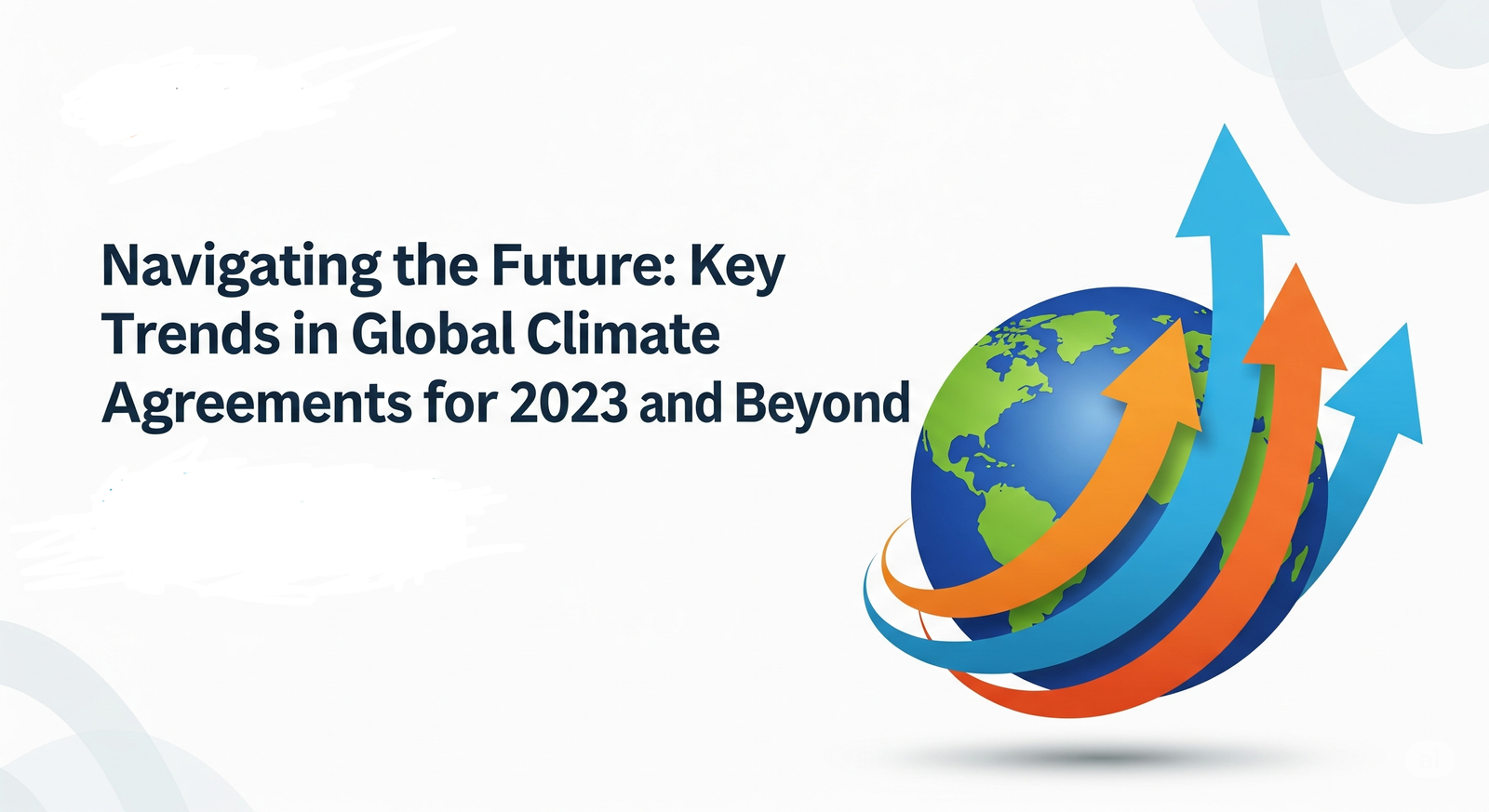Contents
Introduction
In 2015, the Paris Agreement marked a significant milestone in global climate action, aiming to limit global temperature rise to well below 2°C above pre-industrial levels, while trying to limit the rise to 1.5°C. However, as we enter 2023, it has become evident that achieving these targets requires far more than initial commitments. Increased frequency of climate-related disasters, such as wildfires, floods, and hurricanes, coupled with a growing public awareness and activism, has ignited a sense of urgency among nations. The current landscape shows not just a need for renewed commitments, but a shift in how these agreements are structured, implemented, and enforced.
Key trends are emerging in global climate negotiations that reflect the changing priorities and strategies of nations and organizations alike. From the rise of non-state actors in climate governance to the integration of technology and finance in sustainability efforts, the future of global climate agreements is not merely about setting targets. It also involves crafting pathways to achieve those targets while fostering resilience against the impacts of climate change.
This article will unpack these trends while providing expert insights, user testimonials, and practical steps for individuals and organizations to navigate this evolving landscape.
Key Trend 1: Increased Commitment to Net-Zero Targets
One of the most significant trends shaping global climate agreements in 2023 is the global pivot toward net-zero emissions targets. Over the past few years, countries, cities, and corporations have made pledges to achieve carbon neutrality by certain deadlines, often by mid-century. According to a report by the International Energy Agency (IEA), over 90% of global emissions are now covered by some form of net-zero target (IEA, 2022).
Real-World Example: The European Union
The European Union has been at the forefront of this trend, committing to achieving net-zero emissions by 2050 as part of its European Green Deal. This comprehensive strategy aims not only to curb emissions but also to stimulate economic growth through green technologies and a just transition for affected industries. The deal sets legally binding targets for various sectors, including energy, transportation, and agriculture, thereby providing a framework for implementation.
Expert Insights
According to Dr. Emma Hazlewood, a global climate policy expert at the World Resources Institute, “Countries that commit to net-zero targets must also lay out their action plans transparently. This can lead to greater trust and accountability among parties.” She emphasizes the need for developed nations to support developing countries in their transition to low-carbon economies.
Actionable Tips
To align personal and organizational actions with the net-zero trend, consider implementing the following strategies:
-
- Conduct a Carbon Audit: Understand your current carbon footprint to identify areas for improvement.
-
- Invest in Renewable Energy: Wherever possible, consider transitioning to renewable energy sources, such as solar or wind.
-
- Support Green Technologies: Engage with organizations developing sustainable solutions to foster innovation.
Key Trend 2: Emphasis on Climate Justice and Equity
Another important trend in contemporary global climate agreements is the increasing emphasis on climate justice. The concept of climate justice acknowledges that climate change disproportionately affects marginalized communities, poor countries, and indigenous peoples. As such, it’s crucial for climate policies to include provisions that uphold equity and justice.
Real-World Example: The Glasgow Climate Pact
The 2021 UN Global Climate Change Conference (COP26) in Glasgow underscored this principle by emphasizing the importance of financial assistance to support vulnerable nations. The Glasgow Climate Pact called upon developed countries to provide $100 billion annually to developing nations to aid in their climate efforts.
User Experiences
Maria, an activist from the Philippines, reflects on her experience at COP26: “Being a representative from a vulnerable nation, I felt heard for the first time. Global Climate justice needs to be at the forefront of every discussion. Our survival depends on it.”
Actionable Tips
To support global climate justice initiatives, consider:
-
- Educating Yourself: Learn about climate change’s impact on different communities and advocate for inclusive policies.
-
- Supporting Local Organizations: Engage with grassroots organizations working toward equitable climate solutions.
-
- Participating in Advocacy: Lend your voice to support legislation that prioritizes marginalized communities in climate discussions.
Key Trend 3: Leveraging Technology and Innovation
Technological advancements are crucial for achieving ambitious global climate targets. From renewable energy innovations to carbon capture technologies, new tools are continually emerging that could revolutionize our approach to climate change.
Real-World Example: Carbon Capture and Storage (CCS)
One of the most promising technologies in this domain is Carbon Capture and Storage (CCS). This technique captures carbon dioxide emissions at their source, compresses the gas, and stores it underground. Notable projects, like the Quest CCS facility in Canada, have successfully reduced emissions equivalent to taking millions of cars off the road annually.
Expert Insights
According to John Watkins, a researcher specializing in renewable energy technologies, “Investing in research and development for CCS and other clean technologies will be instrumental in meeting global climate targets.” He advocates for public-private partnerships to accelerate this innovation.
Actionable Tips
To stay ahead in the technological landscape, consider:
-
- Subscribing to Tech News: Stay informed about the latest technological innovations in climate science.
-
- Supporting R&D Initiatives: Advocate for increased funding for research into clean technologies.
-
- Engaging with Startups: Explore opportunities to work with or invest in startups innovating in the climate tech sector.
Key Trend 4: Enhanced Role of Non-State Actors
The role of non-state actors—such as cities, businesses, and NGOs—in global climate governance is growing. These entities often act quickly and provide innovative solutions independent of national governments.
Real-World Example: Cities Taking the Lead
Cities like Los Angeles and Copenhagen are pioneering their global climate action plans, often setting more ambitious targets than their respective countries. For instance, Copenhagen aims to become carbon neutral by 2025, showcasing how localized efforts can significantly impact global climate goals.
Expert Insights
Paulina Gawel, a research analyst at C40 Cities, notes: “Cities around the world are becoming climate leaders by implementing sustainable solutions tailored to local needs. Their influence is rising, and they are setting an example for national governments.”
Actionable Tips
To engage with non-state actors in climate action, consider:
-
- Participating in Local Initiatives: Get involved in community-level climate action projects or local government meetings to advocate for environmentally friendly policies.
-
- Supporting Sustainable Businesses: Patronize businesses prioritizing sustainability in their operations.
-
- Networking: Connect with local NGOs committed to climate action for collaborative opportunities.
Read Also: NATO 2025: Adapting Alliances in a Transforming Geopolitical Landscape
FAQs
1. What are the main goals of the Paris Agreement?
The primary goals are to limit global warming to below 2°C while pursuing efforts to limit it to 1.5°C, enhance adaptive capacity, and support developing countries in their climate initiatives.
2. How can individuals contribute to climate action?
Individuals can reduce their carbon footprints by adopting sustainable practices, advocating for climate policies, and supporting organizations that focus on environmental protection.
3. What does “net-zero” mean?
Net-zero refers to achieving a balance between the amount of greenhouse gas emissions produced and the amount removed from the atmosphere, ideally by mid-century.
4. Why is climate justice important in climate agreements?
Climate justice ensures that the voices of marginalized communities are heard in climate action, addressing historical inequities and vulnerabilities that exacerbate the impacts of climate change.
5. How do non-state actors influence climate governance?
Non-state actors, such as businesses and cities, often implement innovative solutions faster than governments, driving local climate initiatives and creating pressure for national-level changes.
Conclusion
Navigating the future of climate agreements requires an understanding of the evolving trends influencing global climate action. The emphasis on net-zero commitments, climate justice, technology, and the role of non-state actors illustrates the multidimensional approach needed to combat climate change effectively.
As individuals and organizations engage with these trends, proactive steps can be taken to align daily practices with broader climate goals, irrespective of geographical or socio-economic backgrounds. Ultimately, the path to a sustainable future demands collective action and accountability, urging everyone to become active participants in mitigating climate change.
In the spirit of continuity and progress, let us forge ahead with innovative solutions, equitable practices, and collaborative efforts to ensure a livable planet for generations to come. Together, we have the capacity to shape a resilient and sustainable future.


